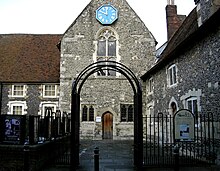Museum of Canterbury

Museum frontage
|
|
| Established | 1987 |
|---|---|
| Location | Stour Street, Canterbury, Kent CT1 2NR |
| Type | Local history museum, Children's museum, Heritage museum |
| Public transit access | Rail: Canterbury West; Canterbury East Buses: National Express; Stagecoach; Canterbury bus station |
| Website | www |
The Canterbury Heritage Museum, (formerly the Museum of Canterbury), is a museum in Stour Street, Canterbury, South East England, telling the history of the city. It is housed in the 12th century Poor Priests' Hospital next to the River Stour. The museum exhibits the Canterbury Cross and contains a gallery dedicated to Rupert the Bear, whose creator Mary Tourtel lived in Canterbury. It holds regular events and exhibitions of local and national interest.
The museum was founded by William Masters, a local nurseryman specializing in exotic plants, who went on to serve as Hon. Curator from 1823 to 1846.
The museum is in the medieval Poor Priests' Hospital with two adjoining buildings, backing on to the River Stour. From 1174 to 1207 the long, low block parallel to Stour Street was the stone house of a tanner, a rich minter and the minter's son, Alexander, who converted it into an almshouse in the name of the Virgin Mary for old and poor priests. The priests used the house as a hall, living, eating and sleeping around a central fire. In 1373 the solar and undercroft were added opposite the present gateway, to give privacy on the upper floor to the master of the hospital. At the other end of the original hall was the service quarter for servants with kitchen, pantry and buttery. Next to the solar is the Chapel of St Mary, which was designed as a single open space with a back kitchen. Two upper floors were later inserted, with windows and chimney. This set of buildings became secular in 1575: a school, poorhouse, workhouse and clinic. The present museum was previously at the Beaney as the Heritage Museum, then was established in Stour Street in 1987 to celebrate local history, and the building restored to show the interior crown-post roof.
...
Wikipedia
